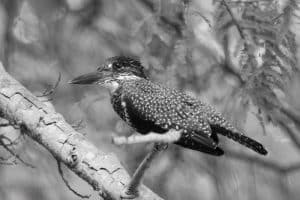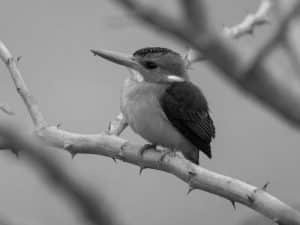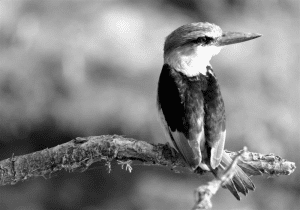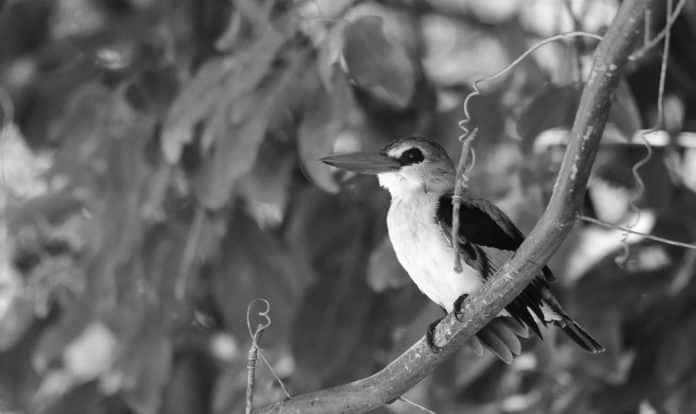Introduction to Kingfishers in Tanzania
Welcome to the stunning world of Tanzania, where the vibrant landscapes are adorned with the graceful presence of kingfishers. These enchanting birds are a sight to behold, with their dazzling plumage and remarkable fishing skills. Tanzania’s diverse habitats provide a perfect haven for a variety of kingfisher species, making it a paradise for birdwatchers and nature enthusiasts. In this article, we will delve into the captivating world of kingfishers in Tanzania, exploring their habitats, behaviors, conservation efforts, and the cultural significance they hold in this beautiful East African country.

Tanzania’s rich and varied ecosystems, from lush forests to shimmering lakes, offer an ideal environment for a wide array of kingfisher species to thrive. The country’s abundant water bodies, including rivers, lakes, and coastal areas, provide ample opportunities for these magnificent birds to display their remarkable fishing prowess. The diverse range of habitats in Tanzania, such as the Serengeti plains, the Selous Game Reserve, and the exotic island of Zanzibar, offer an excellent chance to observe and appreciate the beauty of kingfishers in their natural surroundings.
The Habitat of Kingfishers in Tanzania
The habitat of kingfishers in Tanzania is as diverse as the country itself, encompassing a range of ecosystems that provide these birds with abundant food sources and nesting sites. The lush riverbanks and mangrove swamps serve as prime locations for many kingfisher species to hunt for fish and other aquatic prey. In addition, the tranquil shores of Tanzania’s lakes and reservoirs offer a perfect setting for kingfishers to exhibit their exceptional fishing skills, making them a captivating sight for birdwatchers and photographers alike.
Tanzania’s coastal regions, with their picturesque estuaries and lagoons, provide a haven for kingfishers, where they can thrive in the rich marine environments and find refuge among the dense vegetation. The country’s tropical forests and woodlands are also home to several kingfisher species, where the lush foliage and diverse insect life create an ideal habitat for these colorful birds. Whether it’s the bustling waterways or the serene woodlands, Tanzania’s landscapes offer an enchanting backdrop for the magnificent kingfishers to flourish.
Species of Kingfishers Found in Tanzania
Tanzania is blessed with a remarkable diversity of kingfisher species, each exhibiting its unique traits and characteristics. Among the most iconic species found in Tanzania is the Malachite Kingfisher, with its striking emerald plumage and agile hunting techniques. This dazzling bird can be spotted near the water’s edge, where it perches gracefully before plunging into the water to catch its prey with remarkable precision.
Another notable kingfisher species in Tanzania is the African Pygmy Kingfisher, a diminutive yet vibrant bird that inhabits the country’s wooded savannas and riverine habitats. Its iridescent blue and orange plumage makes it a delightful sight amidst the lush greenery, as it darts swiftly to capture insects and small invertebrates. Tanzania is also home to the Woodland Kingfisher, known for its melodious calls and vibrant blue and white feathers, adding a touch of elegance to the country’s woodlands and open plains.
The elusive and regal Giant Kingfisher is a majestic resident of Tanzania’s waterways, with its impressive size and distinctive black and white plumage. This magnificent bird can be observed near larger rivers and lakes, where it patiently waits for its prey before executing a swift and precise dive. These are just a few examples of the stunning kingfisher species that grace the landscapes of Tanzania, each contributing to the country’s rich avian diversity.
Behaviors and Characteristics of Kingfishers

Kingfishers are known for their remarkable behaviors and unique characteristics, which set them apart as some of the most captivating avian species in Tanzania. Their exceptional fishing abilities, characterized by their swift and precise dives into the water, make them a spectacle to observe in their natural habitats. Their keen eyesight and sharp beaks, perfectly adapted for capturing fish and other aquatic prey, showcase the remarkable evolutionary adaptations of these splendid birds.
The distinctive calls of kingfishers echo through the tranquil landscapes of Tanzania, adding a melodic charm to the natural surroundings. From the rhythmic rattling calls of the Malachite Kingfisher to the melodious trills of the Woodland Kingfisher, these birds contribute to the symphony of sounds that grace the country’s diverse ecosystems. The courtship displays of kingfishers are equally enchanting, as they engage in aerial acrobatics and elaborate rituals to win the favor of their mates, adding an element of grace and beauty to the Tanzanian skies.
Kingfishers are also known for their striking plumage, with a dazzling array of colors and patterns that make them a visual delight for birdwatchers and photographers. The iridescent blues, vibrant greens, and rich chestnut hues of these birds create a captivating spectacle amidst the verdant landscapes of Tanzania, adding a touch of elegance to the natural world. These remarkable behaviors and characteristics make kingfishers a cherished part of Tanzania’s avian tapestry, enriching the country’s natural heritage.
Conservation Efforts for Kingfishers in Tanzania
In recent years, there has been a growing recognition of the need to conserve and protect the diverse bird species, including kingfishers, that inhabit Tanzania’s breathtaking landscapes. Habitat loss, pollution, and human disturbance have posed significant threats to the survival of these magnificent birds, prompting concerted efforts to safeguard their natural habitats and ensure their long-term well-being. Conservation organizations and local communities have been actively involved in initiatives to preserve the habitats and populations of kingfishers in Tanzania.
One of the key conservation strategies for kingfishers in Tanzania involves the protection and restoration of critical habitats, such as riverbanks, wetlands, and forested areas, which are essential for the survival of these birds. By establishing protected areas and implementing sustainable land management practices, conservationists aim to create safe havens for kingfishers to thrive and flourish. Additionally, efforts to raise awareness about the importance of kingfishers and their habitats have been instrumental in garnering support for conservation initiatives across Tanzania.
Research and monitoring programs have played a crucial role in understanding the ecological requirements and population dynamics of kingfishers in Tanzania, providing vital information for conservation planning and management. By studying their behaviors, breeding patterns, and migratory movements, conservationists can develop targeted conservation strategies to address the specific needs of kingfisher species across different ecosystems. Furthermore, partnerships between government agencies, conservation groups, and local communities have been instrumental in implementing conservation measures and fostering a sense of stewardship for Tanzania’s precious avian diversity.
Best Places for Birdwatching and Kingfisher Spotting in Tanzania
Tanzania offers a plethora of exceptional locations for birdwatching and kingfisher spotting, where enthusiasts can immerse themselves in the breathtaking beauty of these remarkable birds. The lush wetlands and riverine habitats of the Selous Game Reserve provide a prime opportunity to observe a diverse array of kingfisher species in their natural environments. The tranquil Rufiji River, which meanders through the reserve, offers a picturesque setting for kingfisher sightings, as these birds elegantly perch on overhanging branches and dart into the water with breathtaking agility.
The Serengeti National Park, renowned for its vast savannas and iconic wildlife, is also a haven for birdwatchers seeking to encounter kingfishers amidst the sweeping plains and acacia woodlands. The park’s seasonal water sources, including the Grumeti and Mara Rivers, attract a variety of kingfisher species, adding a touch of vibrancy to the timeless landscapes. Birdwatching enthusiasts can witness the aerial displays and fishing antics of kingfishers against the backdrop of the Serengeti’s awe-inspiring scenery, creating unforgettable moments in the heart of Tanzania’s wilderness.
The coastal regions of Tanzania, particularly the exotic island of Zanzibar and its surrounding archipelago, offer a captivating setting for birdwatching and kingfisher spotting. The mangrove forests and tidal flats of Zanzibar provide an ideal habitat for several kingfisher species, where their vivid plumage and agile movements complement the enchanting coastal landscapes. Whether it’s the azure waters of the Indian Ocean or the verdant forests of the island, Zanzibar beckons birdwatchers to explore its diverse avian treasures, including the charismatic kingfishers that grace its shores.
Photography Tips for Capturing Kingfishers in Tanzania

Capturing the exquisite beauty and fascinating behaviors of kingfishers in Tanzania through photography requires patience, skill, and an understanding of their natural habitats and habits. Whether you’re an amateur photographer or a seasoned professional, the following tips will help you enhance your photographic journey and create stunning images of these captivating birds amidst Tanzania’s breathtaking landscapes.
- Research and Preparation: Before embarking on a photography expedition to capture kingfishers in Tanzania, take the time to research their behaviors, preferred habitats, and typical feeding grounds. Understanding their routines and movements will enable you to anticipate their actions and position yourself for the best photographic opportunities.
- Choose the Right Equipment: When photographing kingfishers, it’s essential to have the appropriate gear, including a telephoto lens with a focal length that allows you to capture their intricate details from a respectful distance. A sturdy tripod and a camouflage hide can also be valuable tools for achieving steady shots without disturbing the birds.
- Patience and Observation: Kingfishers are known for their swift movements and agile hunting techniques, so patience is key when photographing these birds. Spend time observing their behaviors and movements, and be prepared to wait for the perfect moment to capture their remarkable fishing dives or captivating displays.
- Lighting and Composition: Pay attention to the lighting conditions and composition when photographing kingfishers in Tanzania. Early morning and late afternoon offer soft, golden light that can enhance the colors of their plumage, while experimenting with different angles and perspectives can add depth and interest to your images.
- Respect and Ethical Photography: As you immerse yourself in the world of kingfishers, remember to prioritize ethical photography practices and respect the birds and their habitats. Avoid causing unnecessary disturbance or stress to the birds, and adhere to local regulations and guidelines for wildlife photography.
By applying these photography tips and embracing the natural beauty of Tanzania’s landscapes, you can capture stunning images of kingfishers that convey the splendor and grace of these remarkable birds in their native habitats.
The Role of Kingfishers in Tanzania’s Ecosystem
Kingfishers play a vital role in Tanzania’s diverse ecosystems, contributing to the balance and resilience of the natural environment through their ecological interactions and behaviors. As skilled hunters of fish, small reptiles, and aquatic invertebrates, they help regulate the populations of these prey species, preventing imbalances and maintaining the health of aquatic ecosystems. Their presence as top predators in aquatic habitats influences the dynamics of food webs and contributes to the overall stability of Tanzania’s freshwater and coastal environments.
In addition to their ecological significance as predators, kingfishers also serve as indicators of environmental quality and habitat integrity. Their presence and abundance in specific habitats can provide valuable insights into the health of aquatic ecosystems, signaling the availability of suitable nesting sites, food resources, and water quality. Monitoring the populations and behaviors of kingfishers can thus offer important ecological information that contributes to the conservation and management of Tanzania’s natural resources.
Furthermore, kingfishers contribute to the cultural and aesthetic value of Tanzania’s landscapes, enriching the experiences of visitors and locals alike with their vibrant colors, melodious calls, and captivating behaviors. Their presence in the country’s waterways, wetlands, and woodlands adds a sense of enchantment and harmony to the natural world, reflecting the intrinsic connection between these magnificent birds and the diverse ecosystems they inhabit.
The Cultural Significance of Kingfishers in Tanzania
In Tanzanian folklore and traditions, kingfishers hold a special place as revered and symbolic birds, weaving into the cultural fabric of the country with their enchanting presence and folklore. The vibrant plumage and graceful movements of kingfishers have inspired tales and legends that celebrate their beauty and agility, portraying them as messengers of joy and symbols of good fortune in local narratives. Their association with water and fishing has also established them as symbols of abundance and prosperity in Tanzanian folklore, reflecting the deep-rooted connections between people and the natural world.
The intricate patterns and colors of kingfishers have been reflected in the traditional art and crafts of Tanzania, where their imagery adorns paintings, textiles, and decorative objects, symbolizing the enduring allure and significance of these magnificent birds. Additionally, the distinctive calls and behaviors of kingfishers have found their way into music and oral traditions, enriching the cultural heritage of Tanzania with the melodic echoes of these beloved avian inhabitants.
Moreover, the presence of kingfishers in Tanzania’s landscapes has inspired a sense of wonder and appreciation for the country’s rich biodiversity, instilling a deep respect and admiration for the natural world among its people. The cultural significance of kingfishers in Tanzania transcends folklore and tradition, resonating with a profound connection to the land, the water, and the intricate web of life that sustains the country’s vibrant ecosystems.
Conclusion
In conclusion, the magnificent beauty of kingfishers in Tanzania’s breathtaking landscapes exemplifies the captivating allure of these remarkable birds and their intrinsic connection to the country’s rich natural heritage. From the tranquil riverbanks to the verdant woodlands, kingfishers grace the diverse ecosystems of Tanzania with their vibrant colors, enchanting calls, and remarkable behaviors. As guardians of aquatic habitats and symbols of cultural significance, kingfishers embody the harmonious coexistence of wildlife and people in the remarkable tapestry of Tanzania’s landscapes.
Through conservation efforts, birdwatching experiences, and cultural reflections, the splendor of kingfishers in Tanzania continues to inspire awe and appreciation, fostering a deeper understanding of the intricate relationships that shape the country’s ecosystems and cultural traditions. Whether it’s the iridescent hues of the Malachite Kingfisher or the graceful flights of the Woodland Kingfisher, these captivating birds invite us to cherish and protect the natural wonders that define Tanzania’s enchanting landscapes. As we unveil the magnificent beauty of kingfishers in Tanzania, we celebrate their enduring presence as cherished ambassadors of the country’s natural splendor.

































